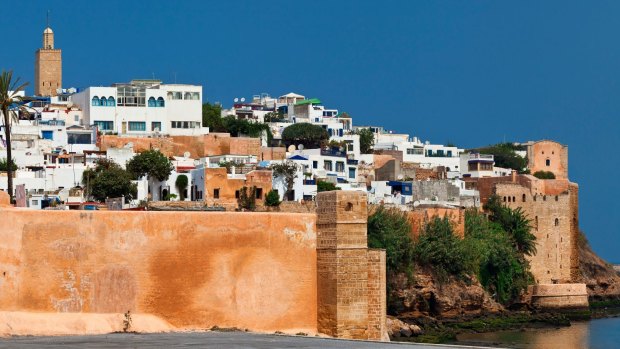
Kasbah des Oudaias.Credit: Alamy
Before I left for Morocco, almost every person I spoke with about my itinerary suggested I cut Rabat out.
"I was there seven years ago, it's just not worth it."
"It's the Canberra of Morocco."
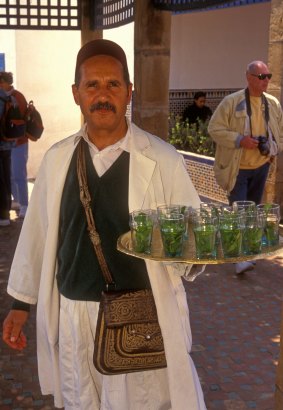
Waiter with a tray of refreshing mint tea at Cafe Maure.Credit: Alamy
These comments and more, and yet I took my chances and went, hoping to discover that the naysayers were wrong. As I wander through the narrow cobbled laneways of Rabat's 12th-century UNESCO-listed Oudaias Kasbah on my first morning in the city, with its Yves Klein blue and whitewashed squat buildings bordered with potted palms and ferns, and doorways dripping with fuchsia bougainvillea, I start to believe they were.
I could be in Greece, I think, as my local guide Aziz and I pass through an ochre-coloured stone archway leading on to a vast windswept patio. The Atlantic Ocean stretches off to our left, the Bouregreg river to our right. As I watch surfers plunging into the waves, kids playing in the shallows and windsurfers rigging up below, I can't help but sigh.
"Is anything wrong?", asks Aziz.
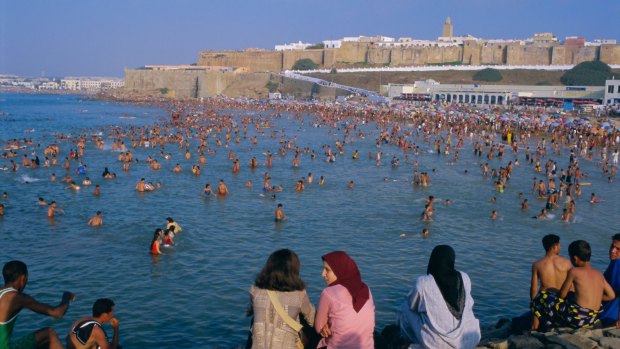
Beach below the Kasbah of the Oudaiah.Credit: Alamy
"No, not at all. I was just thinking how surprised I am by how beautiful Rabat is," I say with a laugh.
"There are lots of surprising things about Rabat," says Aziz mysteriously as he walks back through the archway. I trot after him and we start snaking back through the kasbah, stopping en route to watch a Gnawa musician sing an African Islamic spiritual song, to admire some hand-woven woollen Berber rugs, and to photograph the intricate zellij mosaic work and blue pillared archways of the kasbah's Cafe des Oudaias.
No, this doesn't feel like Canberra at all, I think as we pass through a gate into the Andalusian gardens, overflowing with palms, jacarandas and bougainvillea, fountains and ponds – although I understand the comparison. The city has, like Canberra, been Morocco's political and administrative capital since independence in 1956, and people say that because of all the bureaucrats living there Rabat is dull. And yet, just like Canberra, Rabat is having a renaissance, and maybe even becoming cool.
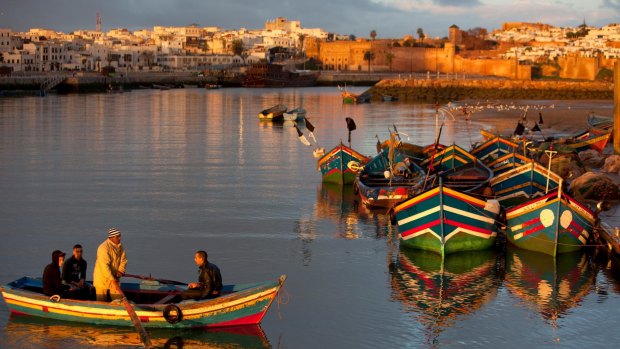
Fishing boats on the Bouregreg river.Credit: Alamy
As we drive through the wide streets, passing the whitewashed bougainvillea-clad houses that characterise the city, Aziz points out the new tramway that opened in 2011, the new "condos" that are popping up around the city, and the Bouregreg Marina which was given a big refresh three years ago.
"The Ritz Carlton is also planning a big urban resort in Rabat, and just over there," says Aziz, sitting up in his seat and pointing to a vague area by the river, "is going to be a new opera house this year – it will be very modern, like Sydney's!" he says, settling back into his seat. "Everybody was thinking Rabat was really boring, but as you can see, things are changing."
Even the city's famed Hassan Tower, which we visit the following morning in Yacoub Al Mansour Square, is being rejuvenated. We pass ceremonial guards on horseback at the square's main gates, and see that the never-completed minaret of the never-completed grand mosque, which was started in 1195, is shrouded in scaffolding. What we can see are the remains of the unfinished mosque, including the 800-year-old walls and partial columns that help me understand the massive scope and size of the building that was intended to be the largest mosque in the world.
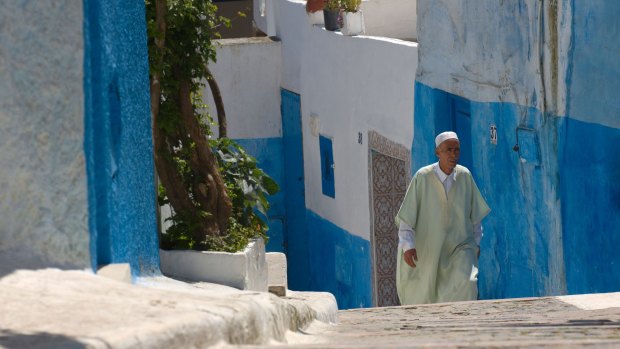
Rabat's 12th-century Oudaias Kasbah. Credit: Alamy
We cross the square to the opulent mausoleum of King Mohammed V, who died in 1961. The stately white structure with its distinctive green tiled roof is both a tomb and a mosque, says Aziz, and is guarded by men clad in bright red uniforms with gold buttons, white gloves and green capes. Inside from the balcony, surrounded by white marble and granite floors, and a stunningly carved ceiling hung with chandeliers, I look down into the tombs of the erstwhile Moroccan king and his two sons.
That afternoon Aziz takes me to Chellah, the medieval fortified necropolis on the southern edge of town. As we walk through the ruins Aziz points out huge storks nesting in the treetops and the tops of the minarets. "When I came here as a kid to play, I'd wonder why the tourists were taking pictures of these old rocks," he says with a laugh as he leads me to the oasis-like gardens filled with huge fig, peach, avocado and pomegranate trees. "This was our Garden of Eden."
We finish up our day outside the Rabat Royal Palace, the official residence of the king of Morocco that lies right in the heart of Rabat. As we stand outside the majestic tiled sandstone entrance watching guards in white balloon pants and blue Fez hats march by, I think how glad I am that I ignored the naysayers and left Rabat, this fascinating cultural hub on the cusp of new beginnings, in my itinerary.
TRIP NOTES
MORE INFORMATION
GETTING THERE
Emirates flies from Sydney and Melbourne to Casablanca via Dubai from about $1680 return. See emirates.com/au.
STAYING THERE
Set in a hectare of citrus groves and lush gardens, the tranquil Villa Mandarine offers a peaceful yet colourfully designed hideaway that feels like an old family home – probably because it was before it was extended into a hotel in 2001, which now has 31 rooms and five suites. Expect to meet the resident peacocks in the open hallways and courtyards, and make sure you try their delectable fish tagine. Rooms start at about $290 a night including breakfast. See villamandarine.com.
TOURING THERE
By Prior Arrangement creates small bespoke luxury tours and private itineraries to Morocco based around shopping, art, architecture, gardens, food or trekking. See bypriorarrangement.com.
Nina Karnikowski travelled as a guest of Villa Mandarine and By Prior Arrangement.
Sign up for the Traveller Deals newsletter
Get exclusive travel deals delivered straight to your inbox. Sign up now.